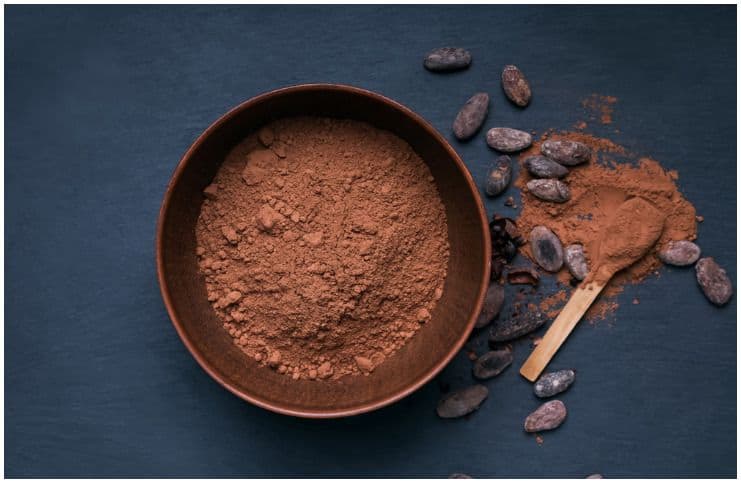Cacao (Cocoa Powder) – Health Benefits & Side Effects:
Facts
Also known as cacao tree and cocoa tree, Theobroma cacao is a small (3 to 9 m tall) evergreen tree in the family Malvaceae (4225+ species), native to the tropical regions of South and Central America, where the Aztecs and Mayans cultivated it for its seeds.
It is now cultivated in most every tropical area in the world, roughly 20 degrees north and south of the equator (also known as „cacao belt”).
The Mayans believed that it was discovered by the gods in the mountains and that it also contained other exquisite foods to be used by the Maya people.
According to Maya mythology, the Plumed Serpent gave the cacao seed to the Mayans after human beings were created from maize by the divine grandmother – Mayan Goddess Xmucane.
Chemical Composition
It contains glycerides (acylglycerols), and its sterols include stigmasterol ergosterol and sitosterol.
The leaf contains gentisic acid, an antirheumatic, and analgesic. Seed compounds include coumarin, esculetin, theobromine, and catechol.
The cocoa bean is a good source of numerous essential minerals, including copper, magnesium, iron, and potassium.
Cocoa vs Cacao
Cocoa is the name used for cacao that has been roasted at very high temperature, which changes the chemical nature of the cacao bean.
This exposure to high temperature diminishes the antioxidant capacity and decreases the nutrient density that is found in the raw, cold-pressed cacao. Else, cacao powder, and cocoa powder are interchangeable.
Uses and Health Benefits of Cacao (Cocoa) Powder
Antioxidant
Research reveals that these beans are perhaps the best source of antioxidants. They contain 3 times more antioxidants than green tea and double the amount found in red wine.
Blueberries are often said to be a high source of antioxidants, however, while blackberries have 2,036 antioxidants and blueberries have 2,400 antioxidants, unprocessed raw cacao have 28,000!
Flavonoids
Flavonoids (or bioflavonoids) come from plants and can be responsible for adding pigmentation and colors and are involved in UV filtration.
They are similar to antioxidants as they have a free radical scavenging capacity and have anti-cancer beneficial properties, while other flavonoids show potential for anti-human immunodeficiency virus (HIV) function.
We get flavonoids from vegetables, fruits, wine, teas, and a significant amount of cacao.
Energy booster
These beans reduce the level of anxiety while simultaneously promoting alertness. A cup of this powder can provide the same energy as a cup of coffee.
Hence, due to the fewer stimulants in cacao, there is no strong crash afterward, as there is in the case of coffee.
Heart health
The magnesium (Mg), copper, and vitamin E in cacao may be helpful in preventing heart disease.
Mg increases and promotes healthy heart function and keeps blood flowing better; copper (Cu) allows blood cells to receive oxygen.
Raises HDL and protects LDL against oxidation
In a controlled trial, cocoa powder was found to greatly decrease oxidized Low-density lipoprotein (LDL) in men. It also increased high-density lipoprotein (HDL) and lowered total LDL in men with a high level of cholesterol.
Health Benefits of Eating Dark Chocolate
Researchers at the Neurosciences Institute in San Diego found that dark chocolate contains at least 3 compounds that closely resemble a naturally occurring neurotransmitter known as „Anandamide,” which induces a sense of well-being.
They also establish compounds (N-acylethanolamines) that block the breakdown of Anandamide (an essential fatty acid neurotransmitter).
Anandamide, derived its name from the Sanskrit word „Ananda”, meaning ‘happiness’ or ‘bliss’. It links to THC receptor sites in the brain, producing a similar, but much less pronounced effect as Tetrahydrocannabinol (THC), which is found in Cannabis.
It is also the essential neurotransmitter present in the uterus during the first months of pregnancy. It would appear that its role here is to chemically create an ambiance of happiness and contentment to welcome the embryonic spirit into the womb.
Dark chocolate is also rich in Phenylethylamine, the same organic compound that is thought to be the chemical instigator for the sense of euphoria that is so particular to the state of „being in love.” No wonder that dark chocolate is widely considered a „comfort food”!
Dark chocolate may also improve the function of the brain. One research of healthy volunteers revealed that 5 days of consuming high-flavanol cocoa improved blood flow to the brain.
Side Effects of Dark Chocolate Consumption
During breastfeeding and pregnancy, consumed in larger amounts, dark chocolate could be unhealthy because of its caffeine content.
The caffeine found in dark chocolate passes into the placenta, making concentrations of fetal blood similar to the levels of the mother’s. There is strong evidence that suggests that high doses of caffeine during pregnancy could be associated with premature delivery, miscarriage, or low birth weight.
Children consuming large amounts of dark chocolate may exhibit tics or restlessness. The active ingredients in chocolate may lead to migraine headaches, and cocoa products may be allergenic.
High amounts of theobromine can affect the body’s central nervous system.
Even in its natural form, theobromine is classified as a drug and can cause anxiety, insomnia, tremors, heart palpitations, restlessness, depression, chronic fatigue, increase urine production, which increases the loss of important electrolytes, severe mood swings, nausea, loss of appetite and vomiting.
Because of the euphoric, mood-elevating effects of theobromine, it can result in a dark chocolate addiction.
READ THIS NEXT:
Bilberries (Vaccinium Myrtillus) – Facts
